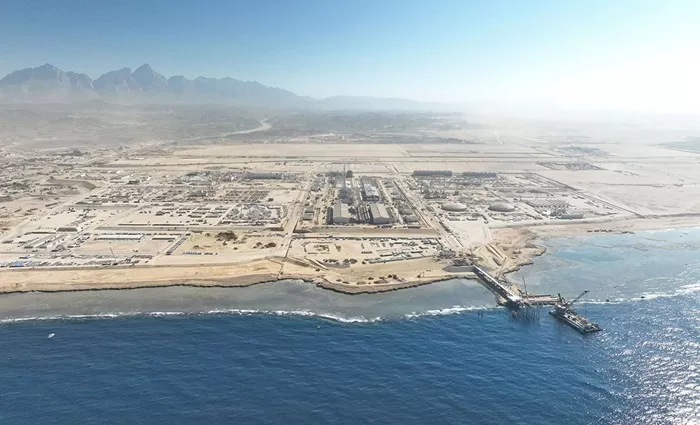Saudi Arabia’s ambitious NEOM Green Hydrogen Project has reached a significant construction milestone, with 80% of work completed across multiple sites, according to project partner Air Products (NYSE:APD). The project, situated within the futuristic NEOM megacity, combines renewable energy generation with hydrogen production and is on track to become the world’s largest renewable-powered ammonia facility.
The integrated complex includes large-scale solar and wind farms with a combined capacity of 4 gigawatts, alongside a state-of-the-art hydrogen production plant and an extensive transmission grid. The facility is expected to commence operations by 2026, with the first exports of green hydrogen—converted into ammonia for easier transport—slated for 2027.
Jointly developed by ACWA Power, Air Products, and NEOM, the project aims to produce up to 600 metric tonnes of green hydrogen daily. This production is intended to support global decarbonization in hard-to-abate sectors such as heavy industry and transport. The NEOM Green Hydrogen Company (NGHC) estimates the plant could offset approximately 5 million metric tonnes of CO₂ annually—comparable to removing over 200,000 vehicles from the road each year. The initiative forms a core component of Saudi Arabia’s Vision 2030 and the Saudi Green Initiative.
Global Struggles, Saudi Progress
While green hydrogen projects in many regions face delays and uncertainty due to a lack of customer offtake agreements and high production costs, Saudi Arabia continues to advance. It reports that only about 12% of global green hydrogen facilities have secured long-term purchase contracts—a key requirement for financing. The cost of green hydrogen, which remains up to four times higher than gray hydrogen produced from fossil fuels, further hampers widespread adoption.
Despite these challenges, NGHC made notable strides in early 2025 when ACWA Power signed a memorandum of understanding with Germany’s SEFE (formerly Gazprom Germania) to supply up to 200,000 tonnes of green hydrogen per year by 2030. While not a binding contract, the agreement highlights growing European interest and contributes to Saudi Arabia’s plan to establish a “hydrogen bridge” to the continent.
Balancing Renewables and Oil
The Kingdom’s green energy push does not signal a retreat from its oil dominance. Saudi Aramco, the national oil company, is simultaneously investing in technologies to reduce emissions from its crude oil operations, which remain around 9 million barrels per day. At its Dhahran R&D center, Aramco is developing innovations that it claims could reduce its carbon footprint by 15% by 2035—equivalent to 51.1 million metric tonnes of CO₂ annually.
“Our strategy is not about replacing one source with another,” said Ahmad Al-Khowaiter, Aramco’s executive vice president for technology and innovation. “It’s about improving the efficiency and sustainability of all forms of energy to meet growing global demand.”
Among these initiatives is a major investment in carbon capture and storage (CCS). Aramco’s Hawiyah gas facility captures carbon dioxide for use in enhanced oil recovery, injecting it into reservoirs over 50 miles away. The company plans to begin storing 9 million tonnes of CO₂ annually at a new facility in Jubail by 2028, aiming to cut CCS costs by 50% to ensure commercial viability.
Additionally, Aramco has expanded its hydrogen portfolio, acquiring a 50% stake in Blue Hydrogen Industrial Gases Company (BHIG), a subsidiary of Air Products Qudra—a joint venture with Qudra Energy of Saudi Arabia.
Mining Sector Emerges as Economic Pillar
As part of a broader strategy to diversify the economy, Saudi Arabia is also ramping up development of its mining industry. The government aims to boost the sector’s contribution to GDP from $17 billion to $75 billion by 2035. Key initiatives include partnerships with major global mining firms such as Barrick Gold, Ma’aden, Zijin Group, and India’s Vedanta.
In December 2024, the Kingdom signed nine investment agreements worth over 35 billion riyals ($9.3 billion) under its Global Supply Chain Resilience Initiative. These deals focus on extracting and processing critical minerals essential for battery manufacturing and global supply chains.
“These agreements strengthen Saudi Arabia’s position as a key supplier of critical materials while building domestic manufacturing capacity and promoting sustainability,” said Minister of Investment Khalid Al-Falih.
With rapid progress on the NEOM Green Hydrogen Project and a strategic blend of renewables, hydrocarbons, and mining, Saudi Arabia is positioning itself as a multifaceted energy and industrial powerhouse for the decades ahead.


